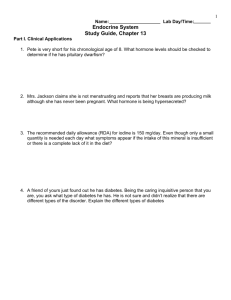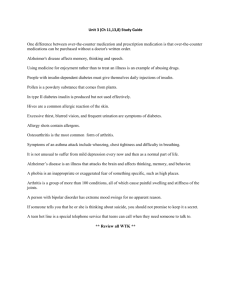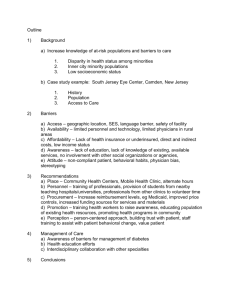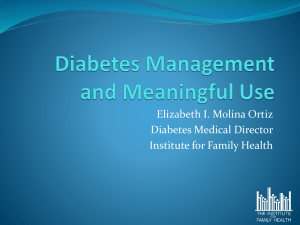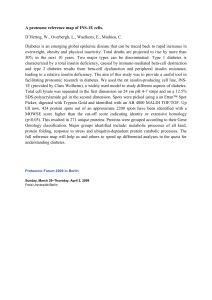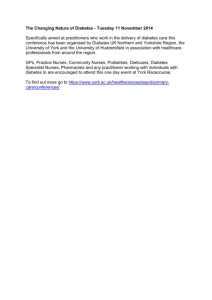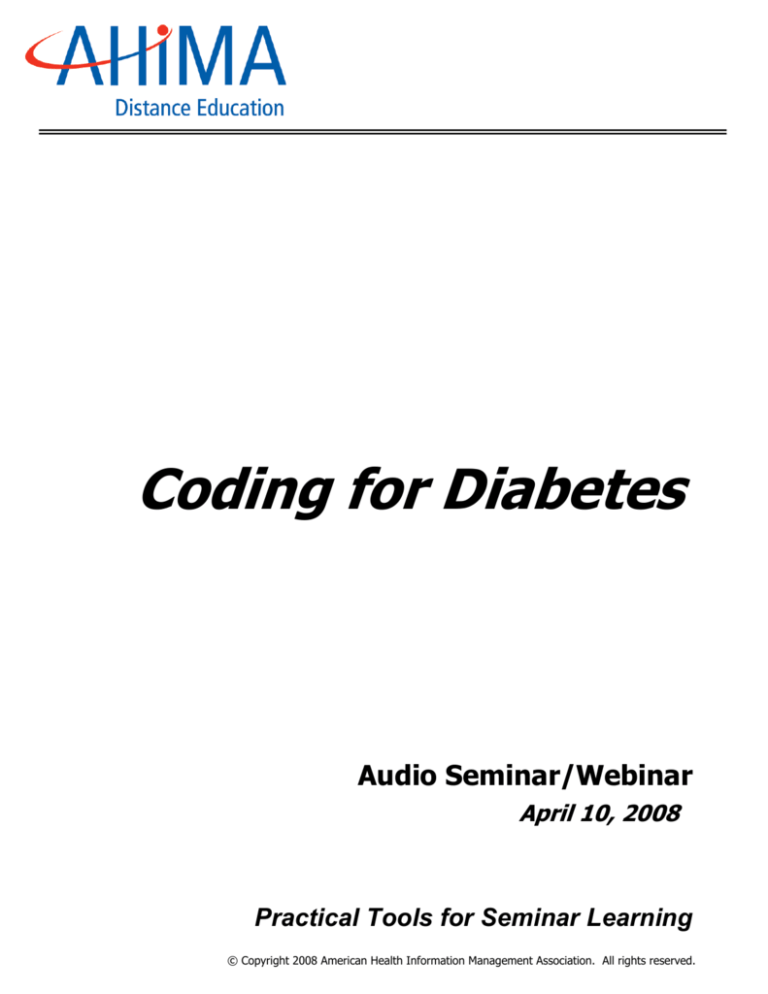
Coding for Diabetes
Audio Seminar/Webinar
April 10, 2008
Practical Tools for Seminar Learning
© Copyright 2008 American Health Information Management Association. All rights reserved.
Disclaimer
The American Health Information Management Association makes no
representation or guarantee with respect to the contents herein and specifically
disclaims any implied guarantee of suitability for any specific purpose. AHIMA has
no liability or responsibility to any person or entity with respect to any loss or
damage caused by the use of this audio seminar, including but not limited to any
loss of revenue, interruption of service, loss of business, or indirect damages
resulting from the use of this program. AHIMA makes no guarantee that the use
of this program will prevent differences of opinion or disputes with Medicare or
other third party payers as to the amount that will be paid to providers of service.
As a provider of continuing education, the American Health Information
Management Association (AHIMA) must assure balance, independence, objectivity
and scientific rigor in all of its endeavors. AHIMA is solely responsible for control of
program objectives and content and the selection of presenters. All speakers and
planning committee members are expected to disclose to the audience: (1) any
significant financial interest or other relationships with the manufacturer(s) or
provider(s) of any commercial product(s) or services(s) discussed in an educational
presentation; (2) any significant financial interest or other relationship with any
companies providing commercial support for the activity; and (3) if the
presentation will include discussion of investigational or unlabeled uses of a
product. The intent of this requirement is not to prevent a speaker with
commercial affiliations from presenting, but rather to provide the participants with
information from which they may make their own judgments.
The faculty has reported no vested interests or disclosures regarding this
presentation.
AHIMA 2008 Audio Seminar Series
CPT® Codes Copyright 2007 by AMA. All Rights Reserved
i
Faculty
Deresa Claybrook, MS, RHIT, is president of Positive Resource
Consulting, focusing primarily on HIM and human resource issues
across all settings. Ms. Claybrook has over 25 years in the HIM field
including experience as a coder, HIM director, instructor, and long
term care administrator. She is currently involved at the state level on
the Oklahoma Health Information Exchange project, and is a frequent
speaker and writer on various HIM topics.
Susan Mitchell, MS, RN, CDE, CNS, is a clinical nurse specialist
and certified diabetes educator at the ediba Diabetes Center for
Excellence (DCE) in Oklahoma City, OK. Ms. Mitchell serves as a
consultant to DEC-affiliated hospitals throughout Oklahoma, assisting
them in establishing inpatient glycemia management programs and
outpatient diabetes education programs. She is also the program
coordinator of the Diabetes Education Program at DCE, which as
achieved recognition from the American Diabetes Association for
meeting national standards for quality diabetes education.
AHIMA 2008 Audio Seminar Series
CPT® Codes Copyright 2007 by AMA. All Rights Reserved
ii
Table of Contents
Disclaimer ..................................................................................................................... i
Faculty .........................................................................................................................ii
Seminar Objectives ........................................................................................................ 1
Polling Question #1........................................................................................................ 1
Diabetes
Information ....................................................................................................... 2
Diagnosing Diabetes ........................................................................................... 4
Polling Question #2 ............................................................................................ 5
Types of Diabetes
Type 1............................................................................................................... 6
Type 2............................................................................................................... 7
Coding Diabetes
Guidelines.......................................................................................................... 8
Gestational Diabetes....................................................................................................... 9
Pre-diabetes .....................................................................................................11
Diabetes Mellitus in Pregnancy and Gestational Diabetes ......................................11
Coding Example ................................................................................................12
Metabolic Syndrome ......................................................................................................12
Complications of Diabetes ..............................................................................................15
Macrovascular Disease .......................................................................................16
Peripheral Neuropathy .......................................................................................16
Autonomic Neuropathy ......................................................................................17
Coding Complication ..........................................................................................18
Nephropathy.....................................................................................................18
Coding Nephropathy ..........................................................................................19
Retinopathy ......................................................................................................21
Coding Ophthalmic Manifestation........................................................................23
Pharmacological Therapy ...............................................................................................24
Insulin Pumps ...............................................................................................................26
Coding Mechanical Devices.................................................................................27
Inpatient Concerns........................................................................................................28
Polling Question #3 ...........................................................................................29
Documentation and Coding ................................................................................31
Acute Complications ..........................................................................................33
Coding Diabetic Ketoacidosis ..............................................................................35
HHS Characteristics and Clinical Findings .............................................................36
Coding Hypoglycemia ........................................................................................37
Resources ....................................................................................................................38
Audience Questions
Appendix
CE Certificate Instructions .....................................................................................43
AHIMA 2008 Audio Seminar Series
Coding for Diabetes
Notes/Comments/Questions
Objectives
Overview of diabetes
Discuss clinical knowledge of
diabetes and it’s complications
affecting other body systems.
Review ICD-9-CM diagnostic coding
guidelines and case scenarios
1
Polling Question #1
What type of facility do you represent?
*1 Hospital
*2 Large Clinic
*3 Physician office
*4 Other setting
2
AHIMA 2008 Audio Seminar Series
1
Coding for Diabetes
Notes/Comments/Questions
Diabetes - an increasing concern
20.8 million with Diabetes in U.S.
(7% of population)
14.6 million diagnosed
6.2 million undiagnosed
41 million with prediabetes
ADA 2005 statistics
3
Every Day:
•
41,000 new diagnosis of diabetes
•
810 die from its complications
•
230 amputations
•
120 go on dialysis
•
55 go blind
4
AHIMA 2008 Audio Seminar Series
2
Coding for Diabetes
Notes/Comments/Questions
What is Diabetes?
Metabolic Disorder
Hyperglycemia
Absolute Deficiency of Insulin
or
Relative Decrease in Secretion &
Effectiveness of Insulin
5
Interplay of Hormones
Insulin-
produced continuously by beta cells in pancreas.
Promotes entry of glucose into cells.
Amylin-
produced by beta cells in pancreas, co- secreted
with insulin. Enhances insulin action, slows gastric
emptying, inhibits glucagon.
Incretin hormones- secreted from gut, GLP-1 and DPP-4
inhibitors. Promote action of insulin, slows gastric
emptying, inhibits glucagon.
Glucagon- produced by alpha cells of pancreas. One of the
counter regulatory hormones which works the
opposite of insulin. Decreases insulin action,
increases glucose production by liver.
Other counter regulatory hormones: cortisol,
growth hormone, epinephrine
6
AHIMA 2008 Audio Seminar Series
3
Coding for Diabetes
Notes/Comments/Questions
Diagnosing Diabetes
• FBG > 126 X 2
• Random BG > 200
plus classic symptoms
` Polyuria
` Polydipsia
` Unexplained weight loss
Normal Blood Glucose (BG)
< 100 mg/ dL
• OGTT 2 hour
` 2 hour sample > 200
• All Plasma Glucose
7
Signs and Symptoms of Diabetes
•
Polyuria
•
Polydypsia
•
Polyphagia
•
Weight loss
•
Nausea, vomiting
•
Blurred vision
•
Fatigue
•
Frequent infections
•
Slow healing
•
Tingling hands and feet
8
AHIMA 2008 Audio Seminar Series
4
Coding for Diabetes
Notes/Comments/Questions
Polling Question #2
How do the majority of your physicians
currently document diabetes mellitus?
*1 IDDM or NIDDM
*2 Type 1 and Type 2 Diabetes
*3 Adult Onset NIDDM or Juvenile IDDM
*4 Type I and Type II Diabetes
*5 All of the above
9
Types of Diabetes
• Type 1 ∅ type I, IDDM
• Type 2 ∅ type II, NIDDM
• Gestational Diabetes
• Other
10
AHIMA 2008 Audio Seminar Series
5
Coding for Diabetes
Notes/Comments/Questions
Type 1
Type 1 “Profile”
Genetic predisposition
Environmental factors
Autoimmune process
10% of diabetes
younger < 30 yr. old
INSULIN DEFICIENCY
Destruction of Beta Cells
prone to ketoacidosis
sudden onset of
symptoms and illness
Insulin Deficiency
11
ENERGY
G
INSULIN
fat
se
o
c
lu
Glu
cos
e
energy
KETONES
AHIMA 2008 Audio Seminar Series
12
6
Coding for Diabetes
Notes/Comments/Questions
Treatment for Type 1
•
Insulin
• Pramlintide (Symlin®)
• Exercise & Nutrition
• Complication Prevention
13
Type 2
Genetic Predisposition
Acquired Factors
Insulin Resistance
(decreased cell sensitivity)
Decreased Insulin Secretion
Increased liver glucose
production
Type 2 “Profile”
• 90% of diabetes
• usually older than
30 years old
• INSULIN
RESISTANCE
• not prone to
ketoacidosis
• gradual onset of
symptoms or none
• 80% overweight ;
20% lean
14
AHIMA 2008 Audio Seminar Series
7
Coding for Diabetes
Notes/Comments/Questions
Treatment for Type 2
• Exercise & Nutrition
• Medications
• Complication prevention
15
Coding Diabetes Guidelines
The below listed diabetes guidelines are not inclusive. The coder should
refer to the applicable Coding Clinic guidelines for additional information
and also ICD-9-CM Official Guidelines for Coding and Reporting Effective
October 1, 2007
Fifth-digits for category 250:
The following are the fifth-digits for the codes under category 250:
0 type II or unspecified type, not stated as uncontrolled
1 type I, [juvenile type], not stated as uncontrolled
2 type II or unspecified type, uncontrolled
3 type I, [juvenile type], uncontrolled
The age of a patient is not the sole determining factor, though most type I
diabetics develop the condition before reaching puberty. For this reason
type I diabetes mellitus is also referred to as juvenile diabetes.
Type of diabetes mellitus not documented
If the type of diabetes mellitus is not documented in the
medical record the default is type II.
16
AHIMA 2008 Audio Seminar Series
8
Coding for Diabetes
Notes/Comments/Questions
Coding Diabetes Guidelines
If the documentation in a medical record does
not indicate the type of diabetes but does
indicate that the patient uses insulin, the
appropriate fifth-digit for type II must be used.
For type II patients who routinely use insulin,
code V58.67, Long-term (current) use of insulin,
should also be assigned to indicate that the
patient uses insulin. Code V58.67 should not be
assigned if insulin is given temporarily to bring a
type II patient’s blood sugar under control during
an encounter.
17
Gestational Diabetes
• Glucose intolerance during
pregnancy
• Women at risk are screened
at 24-28 weeks gestation
• Management – diet/exercise –
glyburide, metformin, insulin
• Resolves after the delivery
• At high risk for developing
type 2 diabetes later in life.
18
AHIMA 2008 Audio Seminar Series
9
Coding for Diabetes
Notes/Comments/Questions
Diagnosis Gestational Diabetes
Fasting
95 mg/dL
1 hour
180 mg/dL
2 hour
155 mg/dL
3 hour
140 mg/dL
100 g glucose load
Diagnosis made with 2 or more elevated values
19
Goals for Pregnancy and Diabetes
Fasting plasma glucose
65 – 100 mg/dL
Postprandial plasma glucose
1 hour:
110 – 135 mg/dL
2 hour:
<120 mg/dL
2 a.m.-6:00 a.m. 65-135 mg/dL
20
AHIMA 2008 Audio Seminar Series
10
Coding for Diabetes
Notes/Comments/Questions
Pre-diabetes
Impaired Fasting Glucose (IFG)
FPG 100-125 mg/dL
Impaired Glucose Tolerance (IGT)
2 hr PG 140-199 mg/dL
21
Diabetes Mellitus in Pregnancy
and Gestational Diabetes
Diabetes mellitus in pregnancy
Diabetes mellitus is a significant complicating factor in pregnancy.
Pregnant women who are diabetic should be assigned code 648.0x,
Diabetes mellitus complicating pregnancy, and a secondary code from
category 250, Diabetes mellitus, to identify the type of diabetes.
Gestational diabetes
Gestational diabetes can occur during the 2nd and 3rd trimester of
pregnancy in women who were not diabetic prior to pregnancy.
Gestational diabetes can cause complications in pregnancy similar to
those of pre-existing diabetes mellitus after pregnancy It also puts
the woman at risk for developing diabetes after pregnancy.
Gestational diabetes is coded to 648.8x Abnormal glucose tolerance.
Codes 648.0x and 648.8x should never be used together on the same
record. Code V58.67. Long term (current) use of insulin, should also
be assigned if the gestational diabetes is being treated with insulin.
22
AHIMA 2008 Audio Seminar Series
11
Coding for Diabetes
Notes/Comments/Questions
Coding for Diabetes
Emergency room visit:
A 28 year old diabetic at 36 weeks gestation presents to the ED this
evening with concerns that the fetus has not moved at all today.
The patient was instructed at her last clinic visit to count fetal
movement during a 30 minute period daily and seek prompt
attention if she noticed a sudden decrease in fetal movement. This is
the patients first pregnancy and control of her type I diabetes has
been fairly adequate throughout the pregnancy. Blood glucose level
in the ED is 120. A limited ultrasound examination demonstrates
fetal movements with normal heartbeat recorded. The patient is
discharged home with instructions to rest on her left side through
the night and report to the obstetrical clinic tomorrow morning.
Code assignment:
655.73 Decreased fetal movements
648.03 Diabetes mellitus complicating pregnancy
250.01 Diabetes mellitus, type 1
23
Metabolic Syndrome
diagnosis when 3 or more risk factors are present
• Elevated blood pressure > 130/85
• Central (abdominal) adiposity
men > 40 in. women > 35 in.
• Low HDL-C men < 40 mg/dL women < 50 mg/dL
• Elevated triglycerides
> 150 mg/dL
• Elevated fasting blood glucose > 100 mg/dL
indicative of insulin resistance
NCEP Adult Treatment Panel III
AHIMA 2008 Audio Seminar Series
24
12
Coding for Diabetes
Notes/Comments/Questions
Glycemic Control Guidelines
ADA
ACE / AACE
Pre-prandial BG
90-130
< 110
Post-prandial 2 hr
< 180
< 140
<7
< 6.5
A1C
American Diabetes Assoc. 2003, American College Clinical Endocrinology 2002
25
Hemoglobin A1C
“average” blood glucose over 3- 4 months
measures amount of glucose that attaches to
protein in the red blood cells- glycosylation
Normal A1C- 4-6%
Higher the glucose in the blood the higher the A1C
results
• For example, a BG of 310 is ~ A1C of 11%
240 is ~ A1C of 9%
170 is ~ A1C of 7%
135 is ~ A1C 0f 6%
26
AHIMA 2008 Audio Seminar Series
13
Coding for Diabetes
Notes/Comments/Questions
Lipid Goals
Cholesterol (mg/dL)
<200
LDL-C (mg/dL)
<100
HDL-C (mg/dL)
> 40
TG (mg/dL)
<150
Blood Pressure Goal
< 130/ 80
27
Long Term Complications
•
•
•
•
•
•
•
Microvascular Disease - retinopathy,
nephropathy, neuropathy (peripheral,
autonomic, cranial)
Macrovascular Disease - cardiovascular,
cerebrovascular, peripheral vascular
Dermatological
Musculoskeletal
Delayed growth and development
Periodontal disease
Unusual infections
28
AHIMA 2008 Audio Seminar Series
14
Coding for Diabetes
Notes/Comments/Questions
Diabetes Associated with
•
•
•
•
•
•
•
Depression
Eating disorders
Thyroid disease
Cystic Fibrosis
Rheumatoid
arthritis
Alzheimer’s disease
Polycystic ovary
syndrome
•
Osteoporosis
•
Sleep apnea
•
Breast Cancer
•
Celiac Disease
29
Complications of Diabetes
25x
2-4x
17x
2-6x
AHIMA 2008 Audio Seminar Series
5x
30
15
Coding for Diabetes
Notes/Comments/Questions
Macrovascular Disease
Diabetes is
Prothrombic
Proinflammatory
Atherosclerosis occurs at earlier age and
advances more rapidly
Manifested as
• Cardiovascular disease
• Cerebrovascular disease
• Peripheral vascular disease
31
Peripheral Neuropathy
Damage is distal and symmetrical
affecting the feet, hands, legs
Insidious onset, progressive
Signs/ symptoms:
painful - shooting, stabbing,
gnawing, burning, extreme
hypersensitivity, severe aching,
worse at night
non painful- numbness, tingling,
dead feet, stocking glove effect
Loss of protective is #1 cause of
ulcers and amputations.
AHIMA 2008 Audio Seminar Series
32
16
Coding for Diabetes
Notes/Comments/Questions
Autonomic Neuropathy
Cardiovascular Autonomic Neuropathy
Postural hypotension, Cardiac denervation,
Fixed heart rate
Gastrointestinal
Gastroparesis (gastropathy)delayed stomach emptying
Diabetic diarrhea, constipation
Genitourinary
Neurogenic bladder
Sexual dysfunction
Impaired insulin counterregulation
Hypoglycemic unawareness
Sudomotor dysfunction (sweating)
Pupillary response
33
Coding for Diabetes and Arteriosclerosis
Condition
ICD-9-CM Codes
Diabetic peripheral
vascular disease causing
intermittent claudication
250.7x, 443.81
Diabetic atherosclerosis
with gangrene
250.7x, 440.24 (Code for
gangrene is included in
440.24)
Note: New 2008 code 440.4
should be used in addition to
code 440.24 if total occlusion
of arteries of the extremities
is present.
34
AHIMA 2008 Audio Seminar Series
17
Coding for Diabetes
Notes/Comments/Questions
Coding Diabetes
Diabetes-Associated Neurological
Complications - 250.6
•
•
•
•
•
•
Polyneuropathy (many nerves) – 357.2
Autonomic neuropathy – 337.1
Gastro paresis (delay in gastric emptying) – 536.3
Mononeuropathy (one nerve) – 354.0-355.9
Neurogenic arthropathy (joint destruction) – 713.5
Amyotrophic (muscle wasting) – 358.1 changed to
353.1 (2008)
35
Nephropathy
Small blood vessels in the nephrons of the kidneys
are damaged- nephrons are the filtering units of
the blood
Hypertension markedly accelerates progression of
diabetic nephropathy
There are NO early warning symptoms
Microalbumin in the urine is the earliest clinical
evidence of kidney damage- screen annually
normal- < 30 microgm/mg
positive- between 30- 300
clinical albuminuria (protein) > 300
AHIMA 2008 Audio Seminar Series
36
18
Coding for Diabetes
Notes/Comments/Questions
Prevent/Delay Nephropathy
• Blood Glucose control
• Blood Pressure control
< 130/80 mm Hg
• ACE inhibitors/ARBs -
anti hypertensive drugs
• Normalize protein in diet
37
Coding Diabetic Nephropathy
If the diagnosis does not state a cause and effect
relationship between diabetes mellitus and chronic
renal failure or chronic uremia the code for chronic
renal failure (585.9) may be assigned as the
principal or first listed code.
Example:
585.9, Chronic renal failure
250.0X, Diabetes Mellitus without mention of complication
If the diagnosis provides a cause and effect
relationship, such as diabetic chronic renal failure,
code 250.4X, Diabetes with renal manifestations, is
required to be sequenced first.
Example: Chronic renal failure due to Type 1 diabetic
nephropathy is coded 250.41, 583.81 and 585.9
Reference: AHA CC 2005 4Q, 2003 1Q, 1991 3Q, 1984-Sept-Oct
AHIMA 2008 Audio Seminar Series
38
19
Coding for Diabetes
Notes/Comments/Questions
Coding Diabetic Nephropathy
Chronic renal failure due to diabetic nephropathy
in a patient with hypertension is coded:
250.40, Diabetes with renal manifestations
type II or unspecified type not stated
as uncontrolled
403.90, Hypertensive chronic kidney disease
with chronic kidney disease, unspecified
585.9, Chronic kidney disease, unspecified
Reference: AHA CC 2006 4Q, 2005 4Q, 2003 1Q
39
Coding for Diabetes
•
•
•
•
•
•
•
DM Renal / Kidney Complications - 250.4
Chronic Kidney Disease – 585.X
Stage I 585.1
Stage II (mild) 585.2
Stage III (moderate) 585.3
Stage IV (severe) 585.4
Stage V (chronic) 585.5
ESRD 585.6
Chronic kidney disease (CKD) 585.9 or CKD
unspecified (chronic renal failure insufficiency)
40
AHIMA 2008 Audio Seminar Series
20
Coding for Diabetes
Notes/Comments/Questions
Retina
41
Retinopathy
Small blood vessels in the retina are damagedretina is the thin, fragile lining in the back of the
eye
Most frequent cause of new blindness
There are NO early warning symptoms
Screening exam for early detection- annual
dilated eye exam
42
AHIMA 2008 Audio Seminar Series
21
Coding for Diabetes
Notes/Comments/Questions
Laser Surgery
Diabetic Retinopathy
43
Diabetic Retinopathy
44
AHIMA 2008 Audio Seminar Series
22
Coding for Diabetes
Notes/Comments/Questions
Coding for Diabetes
•
•
•
•
•
Diabetes-Associated Complications
Ophthalmic Manifestations – 250.5
Cataract 366.41
Glaucoma 365.44
Macular edema 362.07
Retinal edema 362.07 plus retinopathy
Diabetic Retinopathy 362.01 - 362.07
45
Coding for Diabetes
Diabetes-Associated Eye Complications - 250.5
•
•
•
•
•
•
•
Background diabetic retinopathy - 362.01
Proliferate diabetic retinopathy - 362.02
Nonproliferative diabetic retinopathy - 362.03
Mild nonproliferative diabetic retinopathy - 362.04
Moderate nonproliferative diabetic retinopathy - 362.05
Severe nonproliferative diabetic retinopathy - 362.06
Diabetic macular edema - 362.07 *
46
AHIMA 2008 Audio Seminar Series
23
Coding for Diabetes
Notes/Comments/Questions
Coding Diabetes Guidelines
Diabetic retinopathy/diabetic macular edema
Diabetic macular edema, code 362.07, is only present
with diabetic retinopathy. Another code from
subcategory 362.0, Diabetic retinopathy, must be used
with code 362.07. Codes under subcategory 362.0 are
diabetes manifestation codes, so they must be used
following the appropriate diabetes code.
Diabetic macular edema, code 362.07, is only present
with diabetic retinopathy. Another code from
subcategory 362.0, Diabetic retinopathy, must be used
with code 362.07. Codes under subcategory 362.0 are
diabetes manifestation codes, so they must be used
following the appropriate diabetes code.
47
Type 2 Pharmacological Therapy
Secretagogues
Sulfonylureas-
glimepiride (Amaryl)
glyburide (Diabeta, Micronase, Glynase)
glipizide (Glucotrol)
Meglitinides-
repaglinide (Prandin)
nateglinide (Starlix)
Insulin Sensitizers
Biguanides-
metformin (Glucophage)
Thiazolidinediones- pioglitizone (Actos)
rosiglitizone (Advandia)
Delayed Glucose Absorption
Alpha glucosidase Inhibitors- acarbose (Precose)
meglitol (Glyset)
48
AHIMA 2008 Audio Seminar Series
24
Coding for Diabetes
Notes/Comments/Questions
Type 2 Pharmacological Therapy
Combination oral agentsGlucovance
Metaglip
Actoplus met
Avandamet
Avandaryl
duetact
DPP-4 Inhibitor
sitagliptin (Januvia)
Incretin mimetic- injection
exenatide (Byetta)
49
Type 1 & 2 Pharmacological Therapy
Fast and rapid acting insulin- bolus insulin
regular (Humulin R, Novolin R)
lispro (Humalog)
aspart (NovoLog)
glulisine (Apidra)
Intermediate and long acting insulin- basal insulin
NPH (Humulin N, Novolin N)
glargine (Lantus)
detemir (Levemir)
combinations:
Humulin 70/30 and 50/50, Novolin 70/30
Humalog mix 75/25
NovoLog mix 70/30
amylin analog
pramlintide (Symlin)
AHIMA 2008 Audio Seminar Series
50
25
Coding for Diabetes
Notes/Comments/Questions
History of Pumps
51
Coding Diabetes Guidelines
Overdose of insulin due to insulin pump
failure
• The principal or first listed code for an
encounter due to an insulin pump malfunction
resulting in an overdose of insulin, should also
be 996.57, Mechanical complication due to
insulin pump, followed by code 962.3, Poisoning
by insulins and anti-diabetic agents, and the
appropriate diabetes mellitus code based on
documentation.
52
AHIMA 2008 Audio Seminar Series
26
Coding for Diabetes
Notes/Comments/Questions
Coding Diabetes Guidelines
Insulin pump malfunction
(a) Under dose of insulin due to insulin pump failure
An under dose of insulin due to an insulin pump
failure should be assigned 996.57, Mechanical
complication due to insulin pump, as the principal
or first listed code, followed by the appropriate
diabetes mellitus code based on documentation.
53
Coding for Diabetes
A type I diabetic patient is treated due to diabetic
ketoacidosis. The patient’s insulin pump
malfunctioned during the night and stopped
delivering insulin.
Answer and Code Assignment:
996.57, Mechanical complication of other specified
prosthetic device, implant, and graft, due to
insulin pump
Assign code 250.13, Diabetes with ketoacidosis,
type 1 uncontrolled
54
AHIMA 2008 Audio Seminar Series
27
Coding for Diabetes
Notes/Comments/Questions
Inpatient Concerns
Uncontrolled Diabetes or Hyperglycemia
same liability
Hyperglycemia in the Hospital
Diabetes-
previously diagnosed
unrecognized- undiagnosed
Stress hyperglycemia
55
The Hospitalized Patient
Hospitalizations
Costs
LOS
Mortality
56
AHIMA 2008 Audio Seminar Series
28
Coding for Diabetes
Notes/Comments/Questions
Length of Stay Comparison
Patients with no diabetes/indicators
ALOS = 5.0 days
Patients with “250” dx code
ALOS = 6.9 days
Patients with no “250” dx code
on diabetes meds & BG > 180
ALOS = 9.6 days
(63% of total admits)
(25% of total admits)
(12% total admits)
Approx. 40% of total admits have diabetes
and/or indicators
Olson, 2000, INTEGRIS Baptist, OK
57
Polling Question #3
With approx. 40% of total admits
having diabetes and/or indicators,
which of the following documented signs and
symptoms in a medical record may indicate a
patient has diabetes?
*1 Extended length of Stay
*2 Diabetic Medication IV, Subcut, Oral
*3 Signs and symptoms of diabetes
*4 Blood Glucose < 100 mg/dL
*5 Lab or FSBS values above 180
*6 All of the above
58
AHIMA 2008 Audio Seminar Series
29
Coding for Diabetes
Notes/Comments/Questions
Physician Query Process
Reported codes must be supported by
physician documentation.
Abnormal findings are not coded and
reported unless the physician
indicates their clinical significance
59
Deaths Among Hospitalized Patients
12 / 1000
No diabetes diagnosis
27 / 1000
Diabetes diagnosis known
40 / 1000
Unrecognized diabetes
Whitehall 1988
______________________________________________________________
New hyperglycemia
16 %
Known diabetes
3%
Normoglycemia
1.7 %
Umpierrez 2002
60
AHIMA 2008 Audio Seminar Series
30
Coding for Diabetes
Notes/Comments/Questions
Documentation and Coding
One major hospital chart review:
7%
– Diabetes diagnosis mentioned
27% – Hyperglycemia mentioned
66% – No mention of diabetes or
hyperglycemia
Olson, INTEGRIS, 2000
61
BG Control for Hospitalized Patients
Intensive Care
< 110 mg/dL
Non- critical Care Units
< 110 preprandial
< 180 maximum
Pre-labor and Labor &
Delivery
< 100 preprandial
< 120 one hour PP
ACE Consensus Conference Position Statement 2003
62
AHIMA 2008 Audio Seminar Series
31
Coding for Diabetes
Notes/Comments/Questions
BG Control in Hospital affected by:
•
•
•
•
•
•
•
•
Increased insulin resistance
Corticosteroids (ie. Prednisone, Solu
Medrol, etc.)
Infection
TPN (Total Parenteral Nutrition) and Tube
Feedings
Changing IV glucose rates
Decreased physical activity
Unusual timing of insulin injections/ meals
Under use of protocols, overuse of sliding
scale insulin
63
Better Outcomes
Mortality
Infections
Sepsis
DSWI
Blood transfusions
Renal replacement therapy
Ventilator use
Critical illness neuropathy
Antibiotics
LOS
ICU stay
AHIMA 2008 Audio Seminar Series
64
32
Coding for Diabetes
Notes/Comments/Questions
Acute Complications
Diabetic Ketoacidosis (DKA)
associated with type 1
Hyperosmolar Hyperglycemic State (HHS)
associated with type 2
65
Diabetic Ketoacidosis (DKA)
Ketosis
Metabolic acidosis
Hyperglycemia
Dehydration
DKA Signs & Symptoms
3 “Polys”- polyuria, polydypsia, polyphagia
plus
Nausea, vomiting, abdominal pain, “acute abdomen“
Kussmaul respirations
Acetone breath
u drowsiness leading to coma
Signs of dehydration
AHIMA 2008 Audio Seminar Series
66
33
Coding for Diabetes
Notes/Comments/Questions
DKA Clinical Findings
Ketones positive
Serum osmolality variable
BG >250
Serum K+ low, normal, high
Acidosis
Na+ normal, low, high
•
pH <7.2
•
bicarb <15
•
pCO2 <15-20
•
anion gap >12
Fluid deficit approx. 3-7 liters
67
DKA Goals of Therapy
1st Correct acidosis
2nd Normalize blood glucose
3rd Correct fluid deficit
4th Balance electrolytes
5th Prevent reoccurrence
DKA Management
Insulin
Fluids
Potassium
Bicarbonate
68
AHIMA 2008 Audio Seminar Series
34
Coding for Diabetes
Notes/Comments/Questions
Diabetic Coding
Diabetic ketoacidosis
Diabetic ketoacidosis (DKA) is coded to 250.13
with ketoacidosis type I (juvenile type),
uncontrolled. It is uncontrolled by definition
Code 250.13 is the default, unless the physician
specifically documents type II. Prior to 7/15/06
DKA was coded to 250.11 unless specifically
identified as NIDD 250.10.
Reference: AHA CC, 2Q, 2006 pgs 19-20; CC, 3Q, 1991, pgs 6-7
69
Diabetic Coding
Hyperosmolarity/diabetes
Diabetes with Hyperosmolarity (increase in
the concentration of the blood) is coded
250.2x.
Reference: AHA CC, 4Q, 1993, pg 19; CC, 3Q, 1991, pg 7
70
AHIMA 2008 Audio Seminar Series
35
Coding for Diabetes
Notes/Comments/Questions
HHS Key Characteristics
Severe hyperglycemia
Marked dehydration
Neurological changes
Absent or slight ketones
HHS Signs & Symptoms
Decreased mentation or confusion
Lethargy
Focal neuro signs- looks like stroke
Stupor, coma
71
HHS Clinical Findings
•
BG > 600 mg/dL
•
Ketone bodies absent or small
•
Serum osmolality > 320 mOsm/L
•
Fluid deficit 6-12 liters
•
Serum K+ low, normal, high
•
Na+ low, normal, high
72
AHIMA 2008 Audio Seminar Series
36
Coding for Diabetes
Notes/Comments/Questions
HHS Goals of Therapy
1st
Correct fluid deficit
2nd
Balance electrolytes
3rd
Normalize blood glucose
4th
Prevent reoccurrence
HHS Management
Insulin
Fluids
Potassium
73
Coding for Diabetes
Acute Complications of Diabetes
Hypoglycemia = BG less than 70 mg/dL
Hypoglycemia in a Diabetic Patient:
– Diabetic Hypoglycemic Coma - 250.3
– Diabetic Hypoglycemia – 250.8
“hypoglycemic shock” – 250.8
Hypoglycemia in a NON-Diabetic:
– Hypoglycemia Coma – 251.0
– Hypoglycemia, unspecified – 251.2
74
AHIMA 2008 Audio Seminar Series
37
Coding for Diabetes
Notes/Comments/Questions
Resources
American Diabetes Association Clinical Practice
Recommendations: Diabetes Care, Supplement 1, Jan 2008.
www.diabetes.org/diabetescare
The Art and Science of Diabetes Self-Management
Education: A Desk Reference for Healthcare Professionals.
2006, American Association of Diabetes Educators, Chicago,
Illinois.
Diabetes Today: An Update for Healthcare Professionals
manual. 2006, ediba Diabetes Center of Excellence,
Oklahoma City, OK.
ACE position statement PDF link
http://www.aace.com/meeting/consensus/icc/ACEPosiSTAT.pdf
75
Resource/Reference List
•
Diabetes Statistics
http://www.cdc.gov/diabetes/pubs/pdf/ndfs_2005.pdf
•
TMF Health Quality Institute, the Medicare Quality
Improvement Organization for Texas
www.hpmp.tmfhqi.net
•
Archives of Internal Medicine , January 28, 2008,
“Step by Step Medical Coding,” 2008 by Carol Buck
76
AHIMA 2008 Audio Seminar Series
38
Coding for Diabetes
Notes/Comments/Questions
Coding References
ICD-9-CM Official Guidelines for Coding
and Reporting:
http://www.cdc.gov/nchs/datawh/ftpserv/ftpicd9/ftpicd9.htm#
guidelines
AHA Coding Clinic® for ICD-9-CM,
AHIMA Practice Brief: Developing a Physician
Query Process
http://library.ahima.org/xpedio/groups/public/documents
/ahima/bok1_009224.hcsp?dDocName=bok1_009224
77
Audience Questions
AHIMA 2008 Audio Seminar Series
39
Coding for Diabetes
Notes/Comments/Questions
Audio Seminar Discussion
Following today’s live seminar
Available to AHIMA members at
www.AHIMA.org
Click on Communities of Practice (CoP) – icon on top right
AHIMA Member ID number and password required – for members only
Join the Coding Community from your Personal Page
Under Community Discussions, choose the
Audio Seminar Forum
You will be able to:
• Discuss seminar topics
• Network with other AHIMA members
• Enhance your learning experience
AHIMA Audio Seminars
Visit our Web site
http://campus.AHIMA.org
for information on the
2008 seminar schedule.
While online, you can also register
for seminars or order CDs and
pre-recorded Webcasts of
past seminars.
AHIMA 2008 Audio Seminar Series
40
Coding for Diabetes
Notes/Comments/Questions
Upcoming Seminars/Webinars
Wound Care Coding
Faculty: Gloryanne Bryant, RHIA, RHIT, CCS and
Ella James, MS, RHIT, CPHQ
April 24, 2008
Reporting Hospital Outpatient Modifiers
Faculty: Caroline Rader, MBA, MSHCA, CHC, and
Shelley C. Safian, MAOM/HSM, CCS-P, CPC-H, CHA
April 17, 2008
Thank you for joining us today!
Remember − sign on to the
AHIMA Audio Seminars Web site
to complete your evaluation form
and receive your CE Certificate online at:
http://campus.ahima.org/audio/2008seminars.html
Each person seeking CE credit must complete the
sign-in form and evaluation in order to view and
print their CE certificate
Certificates will be awarded for
AHIMA Continuing Education Credit
AHIMA 2008 Audio Seminar Series
41
Appendix
CE Certificate Instructions .....................................................................................43
AHIMA 2008 Audio Seminar Series
42
To receive your
CE Certificate
Please go to the Web site
http://campus.ahima.org/audio/2008seminars.html
click on
“Complete Online Evaluation”
You will be automatically linked to the
CE certificate for this seminar after completing
the evaluation.
Each participant expecting to receive continuing education credit must complete
the online evaluation and sign-in information after the seminar, in order to view
and print the CE certificate.

